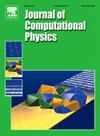Minimum scale and spatial resolution requirement for direct numerical simulations of compressible turbulence
IF 3.8
2区 物理与天体物理
Q2 COMPUTER SCIENCE, INTERDISCIPLINARY APPLICATIONS
引用次数: 0
Abstract
In the direct numerical simulation (DNS) of compressible turbulence using Navier-Stokes equations, due to the incomplete resolution of shocklets, the classical grid resolution criterion based on the usual Kolmogorov length scale appears insufficient for high-order statistics. The present study discusses the minimum scale of compressible turbulence under the continuum assumption, and establishes new spatial resolution requirements for DNS. We first define the minimum shock scale for one-dimensional Burgers turbulence, and derive a spatial resolution criterion essential for fully resolving the second- and third-order velocity gradient moments. We demonstrate that this shock scale definition is also applicable to one-dimensional Navier-Stokes turbulence, and validate the spatial resolution requirement through numerical simulations of the Shu-Osher problem. The analysis is then extended to multi-dimensional turbulence. Through theoretical analysis and numerical studies, we conclude that the minimum local Kolmogorov scale, , describes the smallest structure in turbulence and is determined by the strongest shocklet. Furthermore, we establish a requirement of for compressible turbulence, and validate it through DNSs of two-dimensional compressible turbulence with different grid resolutions. The present study provides a reference on spatial resolution requirement for DNS of compressible turbulence.
可压缩湍流直接数值模拟的最小尺度和空间分辨率要求
在利用Navier-Stokes方程对可压缩湍流进行直接数值模拟(DNS)时,由于激波的不完全分辨,基于通常Kolmogorov长度尺度的经典网格分辨准则对于高阶统计量显得不够充分。本文讨论了连续介质假设下可压缩湍流的最小尺度,并建立了新的DNS空间分辨率要求。我们首先定义了一维Burgers湍流的最小激波尺度,并推导了完全解析二阶和三阶速度梯度矩所必需的空间分辨率准则。我们证明了该激波尺度定义同样适用于一维的Navier-Stokes湍流,并通过Shu-Osher问题的数值模拟验证了空间分辨率要求。然后将分析扩展到多维湍流。通过理论分析和数值研究,我们得出最小局部Kolmogorov标度ηmin描述湍流中最小的结构,并由最强的激波决定。此外,我们还建立了可压缩湍流的ηmin/Δx ̄1.5的要求,并通过不同网格分辨率的二维可压缩湍流的dns进行验证。本文的研究为可压缩湍流DNS的空间分辨率要求提供了参考。
本文章由计算机程序翻译,如有差异,请以英文原文为准。
求助全文
约1分钟内获得全文
求助全文
来源期刊

Journal of Computational Physics
物理-计算机:跨学科应用
CiteScore
7.60
自引率
14.60%
发文量
763
审稿时长
5.8 months
期刊介绍:
Journal of Computational Physics thoroughly treats the computational aspects of physical problems, presenting techniques for the numerical solution of mathematical equations arising in all areas of physics. The journal seeks to emphasize methods that cross disciplinary boundaries.
The Journal of Computational Physics also publishes short notes of 4 pages or less (including figures, tables, and references but excluding title pages). Letters to the Editor commenting on articles already published in this Journal will also be considered. Neither notes nor letters should have an abstract.
 求助内容:
求助内容: 应助结果提醒方式:
应助结果提醒方式:


